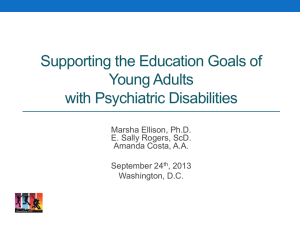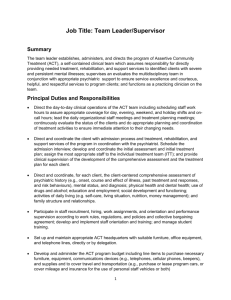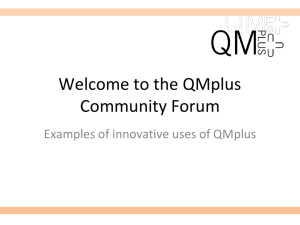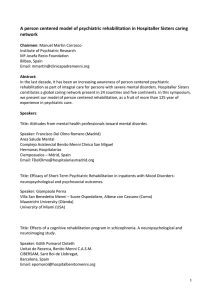The contents of this presentation were developed with funding from
advertisement
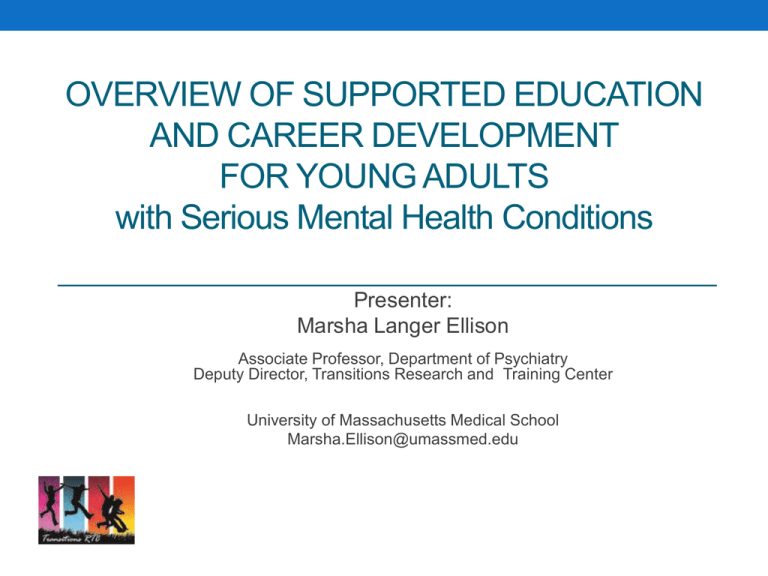
OVERVIEW OF SUPPORTED EDUCATION AND CAREER DEVELOPMENT FOR YOUNG ADULTS with Serious Mental Health Conditions Presenter: Marsha Langer Ellison Associate Professor, Department of Psychiatry Deputy Director, Transitions Research and Training Center University of Massachusetts Medical School Marsha.Ellison@umassmed.edu Acknowledgements The Transitions RTC aims to improve the supports for youth and young adults, ages 14-30, with serious mental health conditions who are trying to successfully complete their schooling and training and move into rewarding work lives. We are located at the University of Massachusetts Medical School, Worcester, MA, Department of Psychiatry, Systems & Psychosocial Advances Research Center. Visit us at: http://www.umassmed.edu/transitionsRTC The contents of this presentation were developed with funding from the US Department of Education, National Institute on Disability, Independent Living, and Rehabilitation Research. The content of this presentation does not necessarily reflect the views of the funding agencies and you should not assume endorsement by the Federal Government. Educational Needs of Individuals with Mental Illness • More than 50% of students 14 years and older with a mental disorder drop out of high school1, the highest drop-out rate for students of any disability group2 • Students with mental health conditions who attend college experience longer delays in entering college4 and continue to show high dropout rates5 • Students with psychiatric conditions have a post–high school employment rate of only 50%3 • Educational attainment is strongly linked with employment and wage earnings6 and predicts later employment among adults with mental illness7 - 9. 3 Michelle Mullen, 2015 Department of Psychiatric Rehabilitation & Counseling Professions 4 What is Supported Education?10 • Supported education (SEd) interventions help individuals with serious mental illness achieve their educational goals. • SEd services include supports to help individuals with mental illness take advantage of skill, career, educational and inter-personal development opportunities within postsecondary educational environments. • SEd helps individuals with serious mental illness to successfully (1) set and achieve an educational goal (e.g., training certificate or degree), (2) improve educational competencies (literacy, study skills, time management), (3) navigate the educational environment (e.g., applications, financial assistance, accommodations), and (4) improve educational attainment. Core Components10 • Specialized staff with time allocated explicitly to SEd services • Service coordination with professionals outside of the SEd program • Coordination with postsecondary education institutions to facilitate course access or within-course assistance • Specialized career counseling, including vocational planning • Skill building to facilitate integration into the academic environment, including stress and time management and academic or study skills training • Financial assistance • On-campus information about student rights and resources • Access to tutoring, library assistance, and other educational support • Mentoring and support, individual or group support, or peer support • General support (off-campus support preferred) for the barriers and life stressors that can lead to educational attrition What’s the Evidence? 10 • Systematic review in 201014 indicates that effectiveness data are limited due to the absence of well-controlled studies, the limited number of studies that examined key outcomes of interest (e.g., degree completion, employment), and short follow-up periods. • Difficulties in SEd research include varying outcomes, populations and settings, absence of a standardized model, and need for long-term follow-up. • Since 2010 five published SEd programs were tested using an experimental design. Findings were positive for education enrollment. • There are ongoing RCT trials, results are pending. 11 Current Approaches: Integration of SEd and Supported Employment • Many young adults desire to work and go to school simultaneously, suggesting the need for integrated supported employment (SE) and SEd services. • The integration of SEd and Individual Placement and Support is being current implemented for young adults with first episode psychotic disorders. • This integration is debated in the field with pros and cons for educational outcomes. Other Current Approaches to SEd 10 • Supported education as part of campus disability services • Supported education as a stand-alone service in a CMHC • Campus-wide wellness and supports for mental health • Supported education for specific populations, e.g., first episode, Veterans, high school drop-outs. From Supported Education to Career Development 15 • What is a career? Any course of employment with a.) Sustained periods of employment in one or a series of related positions; b.) Progressive development of knowledge, skills, and useful expertise; c.) Increasing remuneration consistent with growing expertise 15 • How do you get one? Short term and long term educational paths Training certificate Internships and work experience Career/vocational counseling HELPING YOUTH ON THE PATH 12 TO EMPLOYMENT Survey of Innovative Career 13 Development Practices 11 Kohler Taxonomy Adapted to Programs Serving Young Adults -Focus -Models and Approaches -Engagement and Retention -Meeting Them Where They’re At -Doing Whatever It Takes Family Involvement -Psycho-education Young Adult Focused planning -Planning -Participation -Communication -Support Services -Empowerment -Training Program Structure *listed separately -Life Skills -Employment Skills -Education and Training -Psycho-Education -Social Aspects Young Adult Skill Development * Listed separately Interagency Collaboration -Collective Framework -Collaborative Service Delivery Education and Training • Education Skills Accessing Available Resources Applying for School Transition to College Stress • Financial Aid Planning and Application • Secondary Special Education & Transition Planning • Vocational Schools and Vocational Training APPROACHES TO DELIVERING CAREER DEVELOPMENT SERVICES Practices that are unique to young adults Youth oriented engagement and retention Meeting them where they’re at Specific Practices that are “Unique to the Population” Age Specific Programming Tolerance for Missed Appointments and Gaps in Services Protecting Non-Patient Role Adapting Practices to Fit Developmental Changes Continuous Support Focus on Both Work and School Youth-Oriented Engagement Practices Survey of Innovative practices. Helping Youth on the Path to Employment Development Meeting. New Brunswick, NJ., Rutgers University, 2015 Youth Oriented Engagement and Retention • Build relationships (trusting, genuine, and understanding) • Goal focus • Assertive outreach – in the community; gentle but proactive • Non-treatment environment • Avoiding Diagnosing/Labeling Due to Stigma • Younger staff, connection with youth culture, willingness to engage with social media, ability to text Meeting Them Where They’re At • Literally, service provision in the community, mall, home, school “Meet them where they’re at, on their terms, as often as you need to.” • Figuratively, responding to their felt needs and goals at that time • Varying intensity of services according to need “We’ve had people who were literally unwilling to come out of their room, in fact we had one fellow who was literally in his closet, and we did a series of home visits and we have communicated with people using sticky notes…we’re about as flexible as we can be” Specific Practices for “Meeting Them Where They’re At” Varying Intensity of Services Service Provided According to Need Meeting Anywhere in the Community Goal Setting is Not Dependent on Assessments Using Stages of Behavioral Change Model Matching Interests to Jobs Varied Education Outcomes are Supported Facilitating Communication Between Systems when the Individual Can’t Conclusions • The need for education supports for young adults with SMHC is urgent • SEd may be a promising practice but is not yet evidence- based – more research is needed • “Supported Education” is a service design in flux • Standardization and manualization is needed, but there are clear common practices and core components References 1. Armstrong, K. H., Dedrick, R. F., & Greenbaum, P. E. (2003). Factors associated with community adjustment of young adults with serious emotional disturbance: a longitudinal analysis. Journal of Emotional and Behavioral Disorders, 11(2) 2. U.S. Department of Education. (2004). Twenty-sixth annual report to congress on the implementation of the Individuals with Disabilities Education Act. Washington, DC: U.S. Department of Education. 3. Wagner, M., & Newman, L. (2012). Longitudinal transition outcomes of youth with emotional disturbances. Psychiatric Rehabilitation Journal, 35(3), 199208. 4. Newman, L., Wagner, M., Knokey, A. M., Marder, C., Nagle, K., Shaver, D., & Wei, X. (2011). The Post-High School Outcomes of Young Adults with Disabilities up to 8 Years after High School: A Report from the National Longitudinal Transition Study-2 (NLTS2). Menlo Park, CA: SRI International. 5. Salzer, M. S., Wick, L. C., & Rogers, J. A. (2008). Familiarity with and use of accommodations and supports among postsecondary students with mental illnesses. Psychiatric Services, 59(4), 370-375. 6. U.S. Department of Labor. (2010,). Employment Projections: Education Pays in Higher Earnings and Lower Unemployment Rates. (Report). Retrieved from http://www.bls.gov/emp/ep_chart_001.htm 7. Burke-Miller, J. K., Cook, J. A., Grey, D. D., Razzano, L. A., Blyler, C. R., Leff, H. S., Gold, P. B., Goldberg, R. W., Mueser, K. T., Cook, W. L., Hoppe, S. K., Stewart, M., Blankertz, L., Dudek, K., Taylor, A. L., & Carey, M. A. (2006). Demographic characteristics and employment among people with severe mental illness in a multisite study. Community Mental Health Journal, 42(2), 143-159. 8. Ellison, M. L., Russinova, Z., Lyass, A., & Rogers, E. S. (2008). Professionals and managers with severe mental illnesses: findings from a national survey. Journal of Nervous and Mental Disease, 196(3), 2008 9. Rogers, E. S., Anthony, W. A., Lyass, A., & Penk, W. E. (2006). A randomized clinical trial of vocational rehabilitation for people with psychiatric disabilities. Rehabilitation Counseling Bulletin, 49(3), 143-156. ). 10. Feasibility Study for Demonstration of Supported Education to Promote Educational Attainment and Employment among Individuals with Serious Mental Illness. Ringeisen, H. Ryder-Burge, A., Ellison. M., Biebel, K., & Alikhan, S. RTI International. 11. Nuechterlein, K., Subotnik, K., Turner, L. R., Ventura, J., Becker, D. R., & Drake, R. E. (2008a). Individual placement and support for individuals with recent-onset schizophrenia: integrating supported education and supported employment. Psychiatric Rehabilitation Journal, 31(4), ) 12. Mullen, M. PI. Helping Youth on the Path to Employment: Consensus Conference. Rutgers University, Department of Psychiatric Rehabilitation and Counseling Professions, September 30- October 2, 2015. 13. Mullen, M., Ellison, M., Thompson, J., Huckabee S., & Stone, R. Barriers, Supports, and Innovative Services from Perspectives of Transition-Age Youth and Service Providers. Presented at the Recovery Workforce Summit: 2015 Annual Conference of the Psychiatric Rehabilitation Association. Philadelphia, PA, June, 2015A 14. Rogers, E. S., Kash-Macdonald, M. B. D., & Maru, M. (2010). Systematic Review of Supported Education Literature, 1989-2009. (Report). Boston, MA: Boston University, Sargent College, Center for Psychiatric Rehabilitation. 15. “Transition to Employment for Youth and Young Adults with SMHC” CFDA# 84.133B Grant application submitted by the University of Massachusetts Medical School. Maryann Davis, PI.

